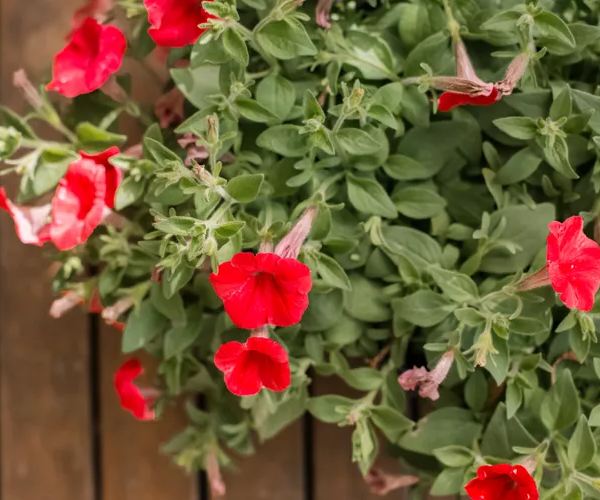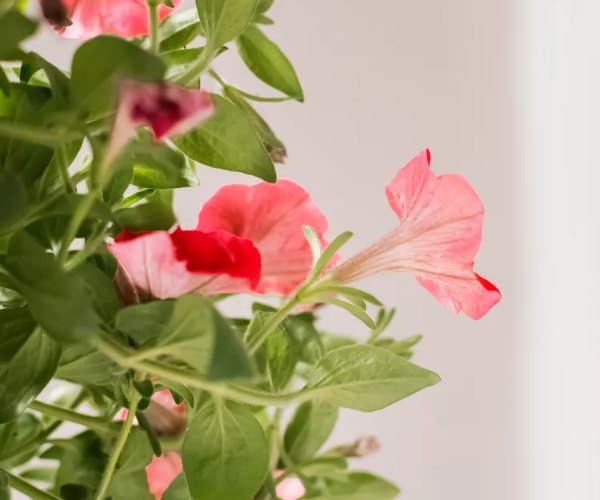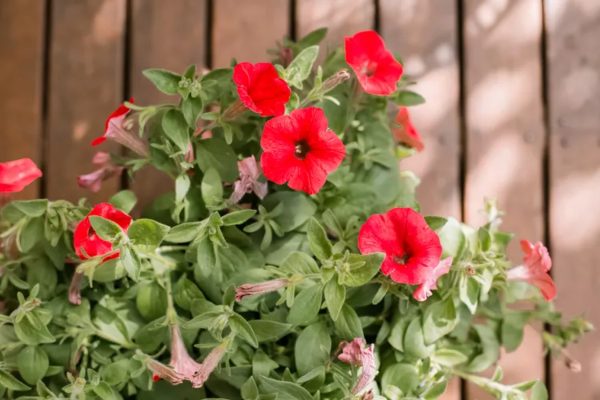While talking about garden flowers, Petunias in flower beds and pots are the names that come to every gardener’s mind. They are great bloomers and you can find them in any color except true blue. They bear wide, trumpet-shaped flowers and branching foliage that is a bit sticky and hairy. There is a great variety within the petunia genus.
Most of these plants are sold as hybrids and they can have single or double blooms; ruffled or smooth petals; striped, veined, or solid colors; mounding or cascading growth habits; and even fragrance.
Petunias grow fast and will reach full size by late spring. Planting petunias depends on your area’s last spring frost date since these plants shouldn’t tolerate any frost. You can have your petunias bloom all summer by providing them with enough sun, water, and fertilizer. Deadheading the spent blooms and pruning improper growth is also very useful. In many cold climates, petunias are annuals and they only last one growing season. In warmer areas, these plants will come back annually but don’t last long. They will self-seed for growth.
Plant Attributes
- Common Name: Petunias
- Botanical Name: Petunia spp.
- Family: Solanaceae
- Plant Type: Annual, perennial
- Mature Size: 6–24 in. tall, 6-36 in. wide
- Sun Exposure: Full
- Soil Type: Well-drained, moist
- Soil pH: Acidic
- Bloom Time: Spring, summer, fall
- Flower Color: Pink, purple, yellow, red, orange, green, white
- Hardiness Zones: 10–11 (USDA)
- Native Area: South America

Types of Petunias
There are different types of petunias according to their appearance and care requirements. According to their character, the petunia varieties are divided into five main groups:
- Grandiflora: These types of petunias have large flowers. But they do not like hot, humid climates.
- Multiflora: These petunia varieties have smaller flowers than the grandiflora types, but they comparatively produce more flowers. They also have a higher tolerance for wet conditions.
- Floribunda: These petunias lie somewhere in between grandiflora and multiflora. They produce many moderately sized flowers.
- Milliflora: The flowers on Milliflora stretch less than 2 inches across. But they are abundant and long-lasting.
- Trailing/spreading: Trailing petunias have a low-to-the-ground, spreading growth habit. They look great as ground cover or spilling over the edges of containers.
How to Care for Petunias
Petunias prefer the sun over shade. But, extreme heat with harsh sun can temporarily damage the blooms. The plants need regular watering and feeding throughout their growing season i.e. spring to fall. They like to be protected from extreme weather which can be moving petunias in pots to a protected area or even setting up a temporary cover over petunias in flower beds.
Also, Read A Complete Guide to Grow and Care for Hens and Chicks Plants
Light
Most petunia varieties like full sun (they need at least six hours of direct sunlight) on most days. But in extreme summers, partial shade will keep them refreshed and give better blooms.
Planting and Soil
Petunias love light, fertile soil that has good drainage. These plants can tolerate different varieties of soil types as long as they provide well-drainage. They also prefer a slightly acidic soil pH. You can plant petunias outdoors once the threat of frost has gone. The soil must be warm and workable for that matter. Remember to space the plants almost a foot apart.

Water
Since they are flowering annuals, petunias do not like being dry for a long time. That being said, they also don’t like soggy soil as it can rot their roots. Again, watering too often can cause the plants to be leggy and produce fewer blooms. Generally, it is enough to soak beds weekly with 1 to 2 inches of water when there is no rainfall. However, there are some spreading petunia types and those in pots that need more deep watering. Do not let the soil dry out more than 2 inches down.
Temperature and Humidity
The normal temperatures for most petunias are around 60 degrees Fahrenheit to 75 degrees Fahrenheit during the day and 55 degrees Fahrenheit to 65 degrees Fahrenheit at night. They can tolerate temperatures up to 40 degrees Fahrenheit. However, frost and freezing temperatures will damage and ultimately destroy the plants. Low or moderate-humid environments are best for them.
Fertilizer
Give your petunias a balanced fertilizer during the planting time. It is also helpful to add some compost to the soil. After that start in July and till fall, fertilize every two to three weeks with a liquid fertilizer that is made especially for flowering plants. Some varieties of spreading petunias require fertilizing every week. That is why it is essential to check your plant’s individual care instructions.
Pruning
When you’re pruning your petunias, pinch back the stems to encourage more branching, ultimately giving a fuller plant look. How far back to pinch solely depends on the plants. If the plant is a short, stocky seedling, just pinch an inch or less than that. In case of a gangly seedling, pinch back the stem by half.
How to propagate petunias
You can propagate petunias via stem cuttings. Normally, gardeners do this if they want to save a particular variety, especially the ones that are rare and hard to find at nurseries and cultivate it indoors over winter until it is perfect to be planted outside during spring. Take the cutting from a healthy petunia plant in the fall before any frost. Here’s how you can do it:
- Cut a healthy portion of the stem that’s around 6 inches long. Choose a green, supple stem over one that’s older and more woody.
- Remove foliage from the bottom half part of the stem.
- Dip the cut end in the rooting hormone. (This is optional)
- Plant the stem in a small pot filled with moistened soilless potting mix, and keep it in bright, indirect light.
- Keep the growing medium moist, and you should have root growth in a few weeks.
- The growing medium must be moist, and roots should develop in a few weeks.
Grow petunias from seed
Most people purchase young petunia plants from a nursery. But it can be worth it to grow these amazing plants from seeds, particularly if you want a particular variety. You have to start your petunia seeds at least 10 to 12 weeks before your area’s last frost date. Here are some steps for planting petunias from seeds:

- Sow the tiny petunia seeds on top of a moist seed-starting mix. Gently press them down, but do not bury them as they need natural light to germinate.
- Then, cover the container with clear plastic, and put it in a warm area but out of direct sunlight. Seedlings should be visible within seven to 10 days.
- Once seedlings emerge, remove the covering.
- When the seedlings get three true leaves, you can transplant them into their own pots until they are ready to be transplanted outdoors.
Potting and repotting petunias
Use a good quality all-purpose potting mix for petunias. You can keep petunias in pots a bit closer than why they’re in flower beds for a proper look. Remember not to plant more than three plants in a pot that is 12 inches wide and deep. The container must contain proper drainage holes. Any pot material is okay but choose a light color so that it prevents the roots from overheating.
You can choose a container that can accommodate your petunias’ mature size as it saves your time and energy from having to repot. If you disturb the roots during the growing season, it will hinder blooming.
Common pests and plant diseases
Some pests that might trouble petunias are aphids, fleas, beetles, slugs, and snails. These insects feed on the stems and leaves. Normally, you can just hose pests off the plants with a strong force of water. However, if the infestation is extreme, you might have to use insecticide.
These plants can be susceptible to fungal diseases like gray mold, mostly in rainy seasons. Choose a variety that has a higher tolerance for moisture if you live in wet areas.
Common Petunia problems
Petunias are mostly easygoing plants and give you nice blooms. But, they also sometimes have issues that you can luckily control.
Wilted leaves or flowers
There are various reasons why petunia flowers and leaves wilt but most of them happen because of water: too much or too little. Check how dry the soil is and if it is not damp, water your petunias. If the soil is moist, avoid watering.
Leggy stems
Petunias often get leggy stems but it is very easy to take care of that. Deadheading flowers regularly and pinching back the stems will help. However, if that doesn’t work, prune the stems back to 2 to 3 inches long. As the plant regrows, it should be less leggy.
FAQs
Q: Are petunias easy to look after?
A: Petunias are super easy to care for, even for beginner gardeners. Give them plenty of sun and regular watering, and they’ll reward you with abundant blooms.
Q: Can I grow petunias indoors?
A: Though it’s more typical to grow petunias outdoors because they need lots of sun and water, it is possible to replicate the conditions indoors for these flowers. Just put them on a very sunny sill, and keep on top of watering. Turn the plants every few days to give them even sun exposure for the best color blooms.
Q: How long do petunias last?
A: In most climates, petunias last one season as annuals. But in certain warm climates, petunias generally last two to three years and will self-seed.
Also, Read How to Grow and Care for Sesame Plants!
